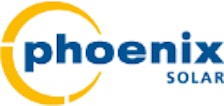Four Singapore-based companies in Singapore won recognition last week at the Singapore Economic Development Board’s (EDB) sixth annual Solar Pioneer Awards for leading the way in adopting solar energy systems in the city-state.
International logistics provider Katoen Natie, multinational conglomerate United Technologies Corporation, storage manufacturers Tech-Link Storage Engineering and real estate investment trust Cambridge Industrial Trust received their awards at the Solarising Singapore conference held on Tuesday.
Launched by the EDB in 2009 when installing solar systems was relatively uncommon, the awards recognise companies that show leadership in using solar systems.
Over the years, the size of projects has grown along with the awards. This year’s winning entries featured systems with a generating capacity up to 6.5 Megawatt-peak (MWp) - up from about 1 MWp seen in winning systems last year, said EDB.
A Megawatt-peak refers to a solar power plant’s capacity under ‘standard test conditions’, where the amount of solar radiation, the temperature of modules, and the angle at which they are exposed to the solar irradiation are fixed. A Megawatt, the plant’s actual output, varies with sunlight intensity.
Goh Chee Kiong, executive director of cleantech, EDB, noted that the growing system sizes enabled companies to reap the benefit of economies of scale.
One solar company behind many projects which have won the Solar Pioneer Awards is Phoenix Solar, the Singapore-based unit of Germany-headquartered Phoenix Solar AG.
Phoenix Solar’s co-founder and managing director Christophe Inglin pointed out that Phoenix Solar’s unbroken winning streak since the launch of the awards – it has won at least two mentions each year from 2009 through to 2014 - “gives feedback to our staff that we’re doing the right thing, motivates us to keep doing it, and attracts other good people who want to join this successful team.”
This year, Phoenix Solar was responsible for Katoen Natie’s winning 1.2MWp photovoltaic (PV) rooftop installation, which EDB recognised for its pragmatic design that integrates solar panels into the roof skylight. It is also the largest rooftop solar installation on Singapore’s Jurong Island.
Koen Cardon, chief executive of the Belgium-headquartered firm’s Singapore office, told Eco-Business that Katoen Natie was proud to have won the award.
He said: “We are considered a pioneer and an innovator in our industry whereby we come up with new ideas and ways of handling and processing new products. The installation of this PV system is just another example of how we make a difference for our customers.”
Phoenix Solar is also behind other installations such as at Tampines Grande, biotechnology firm Lonza Biologics and semiconductor equipment manufacturer Applied Materials, which all won inaugural awards in 2009. The projects were also the first in Singapore to break the 100kWp barrier, and Applied Materials still boasts Singapore’s largest thin film PV installation, with a capacity of 385kWp.
Other winning solar systems include the 707kWp system at the Singapore Sports Hub and Singapore’s largest rooftop installation on the corporate headquarters of supermarket chain Sheng Siong – which was also the first solar PV system in Singapore to cross the 1MWp milestone.
This year, for the first time in the awards history, an individual – real estate investor George Lim - was also recognised as a leading solar adopter in residential buildings.
He received a special mention award at the event. Lim has installed PV systems with a total capacity of 217kWp installed across six houses, all of which have been installed by Phoenix Solar, including a 48.5 kilowatts peak (kWp) system on the roof of his own home,
“
If a company was just installing solar for a bit of greenwash, they would ask about the minimum they can get away with. But going for the maximum size that makes sense shows that a client sees that it makes commercial common sense, and are genuinely interested in investing in solar PV.
Christophe Inglin, managing director, Phoenix Solar
Lim recalled that the cost recovery period for solar installations back in 2009 when he began to explore installing solar systems was 20 years – but this has dropped to about seven years today, he said.
“Then, I didn’t really expect to see financial benefits from the investment,” said Lim. “I just thought it was a good idea to be more conscious about our actions, and contribute to making the world better.”
“The home is cooler due to the panels on the roof, and I was also surprised to learn that the panels generate about S$1,500 worth of electricity a month,” he added.
EDB’s Goh noted that “the returns of investment on solar PV systems have become so evident that even private individuals have started to adopt large scale solar in their residential buildings.”
Inglin added: “Lim is an example of someone who has transitioned through the stages from when a rooftop solar installation was a luxury, to a time when it is so common sense you would be foolhardy not to do it.”
That solar now makes pure economic sense is also evident in the fact that Katoen Natie “went for the maximum solar PV system size that made sense,” says Inglin. That is, the system had to be big enough to meet as much of the company’s operational electricity demand as possible. A capacity that exceeded demand is less viable in Singapore due to the low wholesale rates at which solar energy can be sold back to the main grid.
“If a company was just installing solar for a bit of greenwash, they would ask about the minimum they can get away with. But going for the maximum size shows that a client sees that it makes commercial common sense, and are genuinely interested in investing in solar PV,” he added.
This is a trend that is mirrored in the growth of the Solar Pioneer Awards, added Inglin.
“Around 2009, there was a novelty factor associated with solar, and an award winner stood out as a minority who dared to put PV on their roof. In these early days, the key drivers were intangible benefits such as a Green Mark certification and corporate social responsibility, but today, the main driver is tangible electricity savings,” he said.
Goh also acknowledged that a key aim of the awards is to recognise not only system owners, but also their solar system integrators.
“We hope to help these Singapore-based solar companies build their track record and know-how through ‘learning by doing’,” he said.
Solar companies can look forward to even more growth due to the proven commercial viability of solar in Singapore and strong public sector support through the SolarNova programme, where government buildings will increase their adoption of solar energy, said Goh. SolarNova’s target of 350MW on public sector rooftops by 2020 comes in addition to projected demand from the private sector.
However, a lack of awareness and information about the benefits of solar energy remains, and “it is important that the industry continues to generate awareness through events sharing on best practices, training and other forms of education in order to spread the word about solar,” he added.
The Solarising Singapore conference, held at the Asia Clean Energy Summit and part of the annual Singapore International Energy Week, was held at the Marina Bay Sands Expo and Convention Centre on October 28, 2014.










